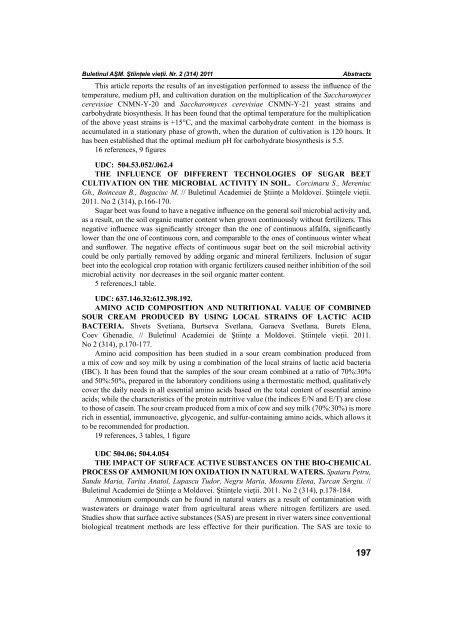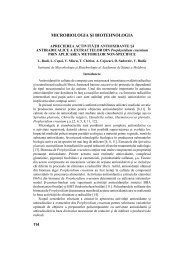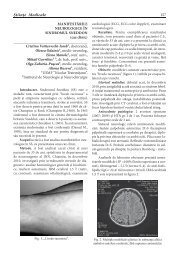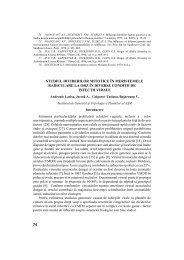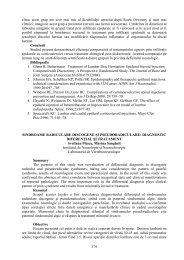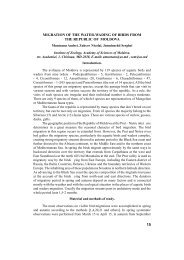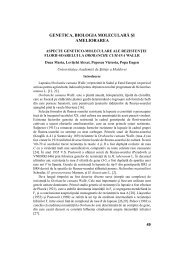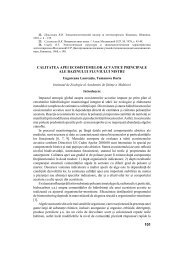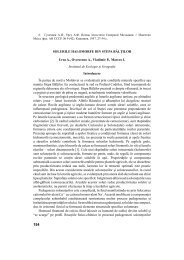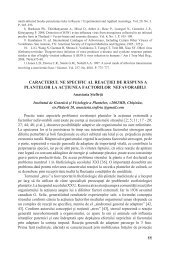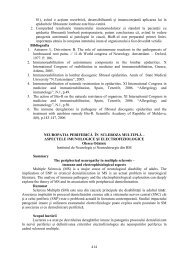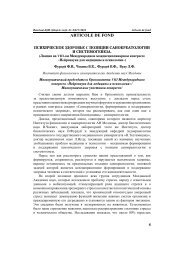209 CONTENTS
209 CONTENTS
209 CONTENTS
You also want an ePaper? Increase the reach of your titles
YUMPU automatically turns print PDFs into web optimized ePapers that Google loves.
Buletinul AŞM. Ştiinţele vieţii. Nr. 2 (314) 2011<br />
Abstracts<br />
This article reports the results of an investigation performed to assess the in uence of the<br />
temperature, medium pH, and cultivation duration on the multiplication of the Saccharomyces<br />
cerevisiae CNMN-Y-20 and Saccharomyces cerevisiae CNMN-Y-21 yeast strains and<br />
carbohydrate biosynthesis. It has been found that the optimal temperature for the multiplication<br />
of the above yeast strains is +15°С, and the maximal carbohydrate content in the biomass is<br />
accumulated in a stationary phase of growth, when the duration of cultivation is 120 hours. It<br />
has been established that the optimal medium pH for carbohydrate biosynthesis is 5.5.<br />
16 references, 9 gures<br />
UDC: 504.53.052/.062.4<br />
THE INFLUENCE OF DIFFERENT TECHNOLOGIES OF SUGAR BEET<br />
CULTIVATION ON THE MICROBIAL ACTIVITY IN SOIL. Corcimaru S., Mereniuc<br />
Gh., Boincean B., Bugaciuc M. // Buletinul Academiei de Ştiinţe a Moldovei. Ştiinţele vieţii.<br />
2011. No 2 (314), p.166-170.<br />
Sugar beet was found to have a negative in uence on the general soil microbial activity and,<br />
as a result, on the soil organic matter content when grown continuously without fertilizers. This<br />
negative in uence was signi cantly stronger than the one of continuous alfalfa, signi cantly<br />
lower than the one of continuous corn, and comparable to the ones of continuous winter wheat<br />
and sun ower. The negative effects of continuous sugar beet on the soil microbial activity<br />
could be only partially removed by adding organic and mineral fertilizers. Inclusion of sugar<br />
beet into the ecological crop rotation with organic fertilizers caused neither inhibition of the soil<br />
microbial activity nor decreases in the soil organic matter content.<br />
5 references,1 table.<br />
UDC: 637.146.32:612.398.192.<br />
AMINO ACID COMPOSITION AND NUTRITIONAL VALUE OF COMBINED<br />
SOUR CREAM PRODUCED BY USING LOCAL STRAINS OF LACTIC ACID<br />
BACTERIA. Shvets Svetiana, Burtseva Svetlana, Garaeva Svetlana, Burets Elena,<br />
Coev Ghenadie. // Buletinul Academiei de Ştiinţe a Moldovei. Ştiinţele vieţii. 2011.<br />
No 2 (314), p.170-177.<br />
Amino acid composition has been studied in a sour cream combination produced from<br />
a mix of cow and soy milk by using a combination of the local strains of lactic acid bacteria<br />
(IBC). It has been found that the samples of the sour cream combined at a ratio of 70%:30%<br />
and 50%:50%, prepared in the laboratory conditions using a thermostatic method, qualitatively<br />
cover the daily needs in all essential amino acids based on the total content of essential amino<br />
acids; while the characteristics of the protein nutritive value (the indices E/N and E/T) are close<br />
to those of casein. The sour cream produced from a mix of cow and soy milk (70%:30%) is more<br />
rich in essential, immunoactive, glycogenic, and sulfur-containing amino acids, which allows it<br />
to be recommended for production.<br />
19 references, 3 tables, 1 gure<br />
UDC 504.06; 504.4.054<br />
THE IMPACT OF SURFACE ACTIVE SUBSTANCES ON THE BIO-CHEMICAL<br />
PROCESS OF AMMONIUM ION OXIDATION IN NATURAL WATERS. Spataru Petru,<br />
Sandu Maria, Tarita Anatol, Lupascu Tudor, Negru Maria, Mosanu Elena, Turcan Sergiu. //<br />
Buletinul Academiei de Ştiinţe a Moldovei. Ştiinţele vieţii. 2011. No 2 (314), p.178-184.<br />
Ammonium compounds can be found in natural waters as a result of contamination with<br />
wastewaters or drainage water from agricultural areas where nitrogen fertilizers are used.<br />
Studies show that surface active substances (SAS) are present in river waters since conventional<br />
biological treatment methods are less effective for their puri cation. The SAS are toxic to<br />
197


